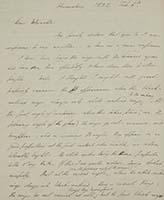Identity area
Reference code
Title
Date(s)
- 6 Feb. 1832 (Creation)
Level of description
Extent and medium
3 pp.
Context area
Name of creator
Repository
Archival history
Immediate source of acquisition or transfer
Content and structure area
Scope and content
Observatory - GA gives a description of his observations of light polarised through glass and a diamond: 'At the first angle of incidence where this takes place (viz. the polarising angle of the glass) the rings go out, evanesce, and disappear: and on increasing the angle they appear in as good proportions at the first instant when visible as when tolerably bright - the white center having the same proportion to the 1st ring did. Of this I am quite certain, having looked carefully. But at the second angle (viz. the polarising angle of the diamond), where the white-centered rings change into black-centered, there is no such thing; the rings do not vanish at all though they become faint; but the first black ring contracts, squeezes out the white center, and itself becomes the black center. This also I have examined carefully. The same thing takes place when, at an angle between the polarizing angles, the tourmaline or prism is turned round'. Amongst other things this proves that the 'diamond does not polarise perfectly at any angle'. Vibrations in the plane of incidence change from + to - on passing through the angle where the polarisation is nearest to perfection. This is 'not by becoming =0 (as certainly they do in glass & all things that polarise perfectly) but by an alteration of the plane.'

